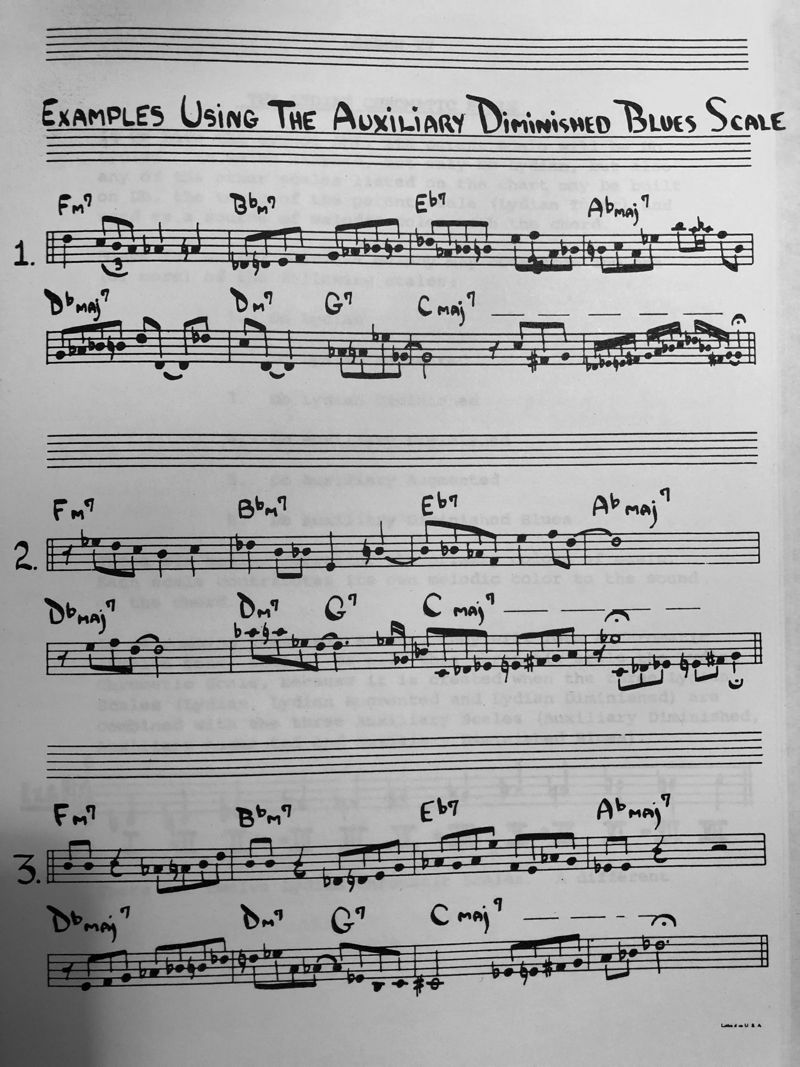I was right though in the fact that only one of the two possible D dim scales contains the Bb/A#. So, I'm back to "not necessarily".jancivil wrote: ↑Thu Apr 25, 2019 2:03 amWell, it was there in the scale given. G Ab A#. Everyone doing it in jazz knows from G Ab A# or Bb for G7b9 #9 (#11 13) with no worries. The application for a dominant 7th in that usage is necessarily true. G A Bb C Db Eb E F#: you would almost never want C or F# over a G B F so it's kind of a moot point for 'chord/scale theory' tbh.datroof wrote: ↑Thu Apr 25, 2019 1:32 amYes, the Ab dim (whole-half) would be the go-to for G7b9, or G7alt. Not so much for G7#9, especially if you want the classic #9 sound. D dim (as CTurner said) would only work as half-whole, which is usually not the default. That's why I say "not necessarily".jancivil wrote: ↑Thu Apr 25, 2019 12:35 am
*Which* #9 chord does it not work on?
G7#9 was given; G Ab A# B C# D E F; 1 b9 #9 3 #11 5 13 7
[...]
now the other symmetrical octatonic.
A7: A Bb B# C# D# E F# G; same relation to the chord.
[...]
Symmetrical octatonic is a go-to if you want b9 and #9 in the same chord. Literally necessarily true.
Unless one doesn't get the whole 0 1 3 or 0 2 3 basis for the scale, then you do have a 50% chance at the mistake.
Theory behind a 4th inversion G7#9 chord with a dropped 5th?
-
- KVRist
- 196 posts since 19 Sep, 2012
-
- KVRist
- 196 posts since 19 Sep, 2012
The real go-to scale for G7 altered would Ab melminor, which contain almost all of the alterations you could want (I know you know this). Followed by C harm minor scale, which has nice gravity toward Cmi. Ab dim (scale) is on the list, but not top of the list.
- KVRAF
- 25053 posts since 20 Oct, 2007 from gonesville
"Ab melodic minor" is typically seen as "Db Lydian Dominant", its 4th mode. So in the sense of 'altered dominant' being 'flat five substitution principle', Db is a flat 5 literally vs the #11 in the symm. octatonic along with a regular P5 D. It depends on what you want to do. I don't care much about it as an academic kind of a deal: you can't think and play at the same time. 
but an argument for symm. octatonic would now contain b9 for the Db7.
but an argument for symm. octatonic would now contain b9 for the Db7.
- KVRian
- 698 posts since 7 Dec, 2009 from GWB
Although in the history of Chord/Scale, half-whole seems the first one presented. This from George Russell's Lydian Chromatic Concept:

- KVRAF
- 25053 posts since 20 Oct, 2007 from gonesville
It's Messiaen's 2nd mode of limited transposition, in "Technique de mon langage musical" - 1944.
"it's usually not the default" is doing too much, frankly. I've never heard anyone talk like that.
It appears originally starting with a semitone, but who cares. There's two ways of ordering it, it's a 50/50 proposition.
Chord/scale theory is pretty academic. What does your ear want in the moment.
"it's usually not the default" is doing too much, frankly. I've never heard anyone talk like that.
It appears originally starting with a semitone, but who cares. There's two ways of ordering it, it's a 50/50 proposition.
Chord/scale theory is pretty academic. What does your ear want in the moment.
- KVRian
- 698 posts since 7 Dec, 2009 from GWB
If your performance is short enough, you can play anything. John Cage understood this when he composed 4’33”, and not 43’30”.




